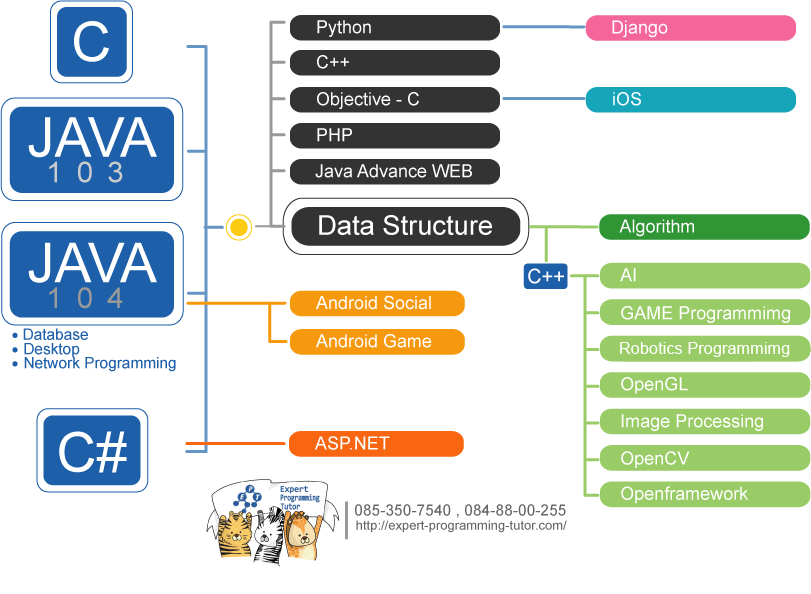เรียนเขียนโปรแกรมง่ายๆกับ Expert Programming Tutor วันนี้เราจะมาเข้าสู่บทData Types
Data type ถือเป็นตัวสำคัญใน python ซึ่งตัวแปรสามารถเก็บข้อมูลประเภทต่าง ๆ ซึ่งมีชนิดข้อมูลดังต่อไปนี้
ชนิดข้อมูล(Built-in Data Types)
Text Type: str
Numeric Types: int, float, complex
Sequence Types: list, tuple, range
Mapping Type: dict
Set Types: set, frozenset
Boolean Type : bool
Binary Types: bytes, bytearray, memoryview
รับประเภทข้อมูล
การตรวจสอบชนิดข้อมูลจะใช้ฟังก์ชัน Type() ในการตรวจสอบ
ตัวอย่าง
บรรทัดที่ 1 สร้างตัวแปร x ขึ้นมา พร้อมกับกำหนดค่า x
บรรทัดที่ 2 ใช้ฟังก์ชัน type() โดยส่งตัวแปร x เป็นอากิวเมนต์เข้าไป เพื่อดึงชนิดข้อมูลของตัวแปร x ออกมาแสดงผ่านฟังก์ชัน print()
|
x = 5 |
ผลลัพธ์
|
< class 'int' > |
การตั้งค่าชนิดข้อมูลเฉพาะ
ใน Python ชนิดข้อมูลจะถูกตั้งค่าเมื่อนักเรียนกำหนดค่าให้กับตัวแปร
Number ข้อมูลที่เป็นตัวเลข ซึ่งจะแบ่งออกเป็น Integer Float และ Complex
int
Int หรือจำนวนเต็มเป็นจำนวนเต็มบวกหรือลบโดยไม่มีทศนิยมความยาวไม่จำกัด
บรรทัดที่ 1 สร้างตัวแปร x ขึ้นมา และกำหนดค่าพร้อมทั้งกำหนดชนิดข้อมูลเป็นประเภท Number ด้วยในคราวเดียวกัน
บรรทัดที่ 3 ใช้ฟังก์ชัน print() ให้แสดงค่าของตัวแปร x ออกมา
บรรทัดที่ 5 ใช้ฟังก์ชัน type() โดยส่งตัวแปร x เป็นอากิวเมนต์เข้าไป เพื่อดึงชนิดข้อมูลของตัวแปร x ออกมาแสดงผ่านฟังก์ชัน print()
ตัวอย่าง
|
x = 20 |
ผลลัพธ์
|
20 |
float
"เลขทศนิยม" เป็นตัวเลขบวกหรือลบประกอบด้วยทศนิยมหนึ่งตัวหรือมากกว่าสองตัว
บรรทัดที่ 1 สร้างตัวแปร x ขึ้นมา และกำหนดค่าพร้อมทั้งกำหนดชนิดข้อมูลเป็นประเภท Number ด้วยในคราวเดียวกัน
บรรทัดที่ 3 ใช้ฟังก์ชัน print() ให้แสดงค่าของตัวแปร x ออกมา
บรรทัดที่ 5 ใช้ฟังก์ชัน type() โดยส่งตัวแปร x เป็นอากิวเมนต์เข้าไป เพื่อดึงชนิดข้อมูลของตัวแปร x ออกมาแสดงผ่านฟังก์ชัน print()
ตัวอย่าง
|
x = 20.5 |
ผลลัพธ์
|
20.5 |
complex
จำนวนเชิงซ้อนจะถูกเขียนด้วย "j" เป็นส่วนจินตภาพ
บรรทัดที่ 1 สร้างตัวแปร x ขึ้นมา และกำหนดค่าพร้อมทั้งกำหนดชนิดข้อมูลเป็นประเภท Number ด้วยในคราวเดียวกัน
บรรทัดที่ 3 ใช้ฟังก์ชัน print() ให้แสดงค่าของตัวแปร x ออกมา
บรรทัดที่ 5 ใช้ฟังก์ชัน type() โดยส่งตัวแปร x เป็นอากิวเมนต์เข้าไป เพื่อดึงชนิดข้อมูลของตัวแปร x ออกมาแสดงผ่านฟังก์ชัน print()
ตัวอย่าง
|
x = 1j |
ผลลัพธ์
|
lj |
String
แปลงข้อมูลเป็นชนิด string โดยสามารถแปลงข้อมูลจากชนิดอื่น ๆ ได้ เช่น ข้อความ ตัวเลขจำนวนเต็ม จุดทศนิยม
ตัวอย่าง
บรรทัดที่ 1 สร้างตัวแปร x ขึ้นมา และกำหนดค่าพร้อมทั้งกำหนดชนิดข้อมูลเป็นประเภท String ด้วยในคราวเดียวกัน
บรรทัดที่ 3 ใช้ฟังก์ชัน print() ให้แสดงค่าของตัวแปร x ออกมา
บรรทัดที่ 5 ใช้ฟังก์ชัน type() โดยส่งตัวแปร x เป็นอากิวเมนต์เข้าไป เพื่อดึงชนิดข้อมูลของตัวแปร x ออกมาแสดงผ่านฟังก์ชัน print()
|
x = "Hello World" |
ผลลัพธ์
|
Hello World |
List
เป็นข้อมูลประเภทรายการ ทำการเปลี่ยนแปลงได้ และอนุญาตสมาชิกที่ซ้ำกัน
ตัวอย่าง
บรรทัดที่ 1 สร้างตัวแปร x ขึ้นมา และกำหนดค่าพร้อมทั้งกำหนดชนิดข้อมูลเป็นประเภท list ด้วยในคราวเดียวกัน
บรรทัดที่ 3 ใช้ฟังก์ชัน print() ให้แสดงค่าของตัวแปร x ออกมา
บรรทัดที่ 5 ใช้ฟังก์ชัน type() โดยส่งตัวแปร x เป็นอากิวเมนต์เข้าไป เพื่อดึงชนิดข้อมูลของตัวแปร x ออกมาแสดงผ่านฟังก์ชัน print()
|
x = ["apple", "banana", "cherry"] |
ผลลัพธ์
|
['apple', 'banana', 'cherry'] |
Tuple
เป็นคอลเลคชันที่เรียงลำดับและไม่สามารถเปลี่ยนแปลงได้ อนุญาตสมาชิกที่ซ้ำกัน
ตัวอย่าง
บรรทัดที่ 1 สร้างตัวแปร x ขึ้นมา และกำหนดค่าพร้อมทั้งกำหนดชนิดข้อมูลเป็นประเภท Tuple ด้วยในคราวเดียวกัน
บรรทัดที่ 3 ใช้ฟังก์ชัน print() ให้แสดงค่าของตัวแปร x ออกมา
บรรทัดที่ 5 ใช้ฟังก์ชัน type() โดยส่งตัวแปร x เป็นอากิวเมนต์เข้าไป เพื่อดึงชนิดข้อมูลของตัวแปร x ออกมาแสดงผ่านฟังก์ชัน print()
|
x = ("apple", "banana", "cherry") |
ผลลัพธ์
|
('apple', 'banana', 'cherry') |
range
เป็นการลำดับตัวเลขตามจำนวนครั้งที่ระบุ
ตัวอย่าง
บรรทัดที่ 1 สร้างตัวแปร x ขึ้นมา และกำหนดค่าพร้อมทั้งกำหนดชนิดข้อมูลเป็นประเภท range ด้วยในคราวเดียวกัน
บรรทัดที่ 3 ใช้ฟังก์ชัน print() ให้แสดงค่าของตัวแปร x ออกมา
บรรทัดที่ 5 ใช้ฟังก์ชัน type() โดยส่งตัวแปร x เป็นอากิวเมนต์เข้าไป เพื่อดึงชนิดข้อมูลของตัวแปร x ออกมาแสดงผ่านฟังก์ชัน print()
|
x = range(6) |
ผลลัพธ์
|
range(0, 6) |
Dictionary
ประเภทดิกชินนารี จะไม่เรียงลำดับ เปลี่ยนแปลงได้ ไม่มีสมาชิกที่ซ้ำกัน
ตัวอย่าง
บรรทัดที่ 1 สร้างตัวแปร x ขึ้นมา และกำหนดค่าพร้อมทั้งกำหนดชนิดข้อมูลเป็นประเภท dict ด้วยในคราวเดียวกัน
บรรทัดที่ 3 ใช้ฟังก์ชัน print() ให้แสดงค่าของตัวแปร x ออกมา
บรรทัดที่ 5 ใช้ฟังก์ชัน type() โดยส่งตัวแปร x เป็นอากิวเมนต์เข้าไป เพื่อดึงชนิดข้อมูลของตัวแปร x ออกมาแสดงผ่านฟังก์ชัน print()
|
x = {"name" : "John", "age" : 36} |
ผลลัพธ์
|
{'name': 'John', 'age': 36} |
Set
เป็นคอลเล็กชันที่ไม่ได้เรียงลำดับและไม่มีสมาชิกที่ซ้ำกัน
ตัวอย่าง
บรรทัดที่ 1 สร้างตัวแปร x ขึ้นมา และกำหนดค่าพร้อมทั้งกำหนดชนิดข้อมูลเป็นประเภท set ด้วยในคราวเดียวกัน
บรรทัดที่ 3 ใช้ฟังก์ชัน print() ให้แสดงค่าของตัวแปร x ออกมา
บรรทัดที่ 5 ใช้ฟังก์ชัน type() โดยส่งตัวแปร x เป็นอากิวเมนต์เข้าไป เพื่อดึงชนิดข้อมูลของตัวแปร x ออกมาแสดงผ่านฟังก์ชัน print()
|
x = {"apple", "banana", "cherry"} #display the data type of x: print(type(x)) |
ผลลัพธ์
|
{'apple', 'cherry', 'banana'} |
Frozenset
ตัวอย่าง
บรรทัดที่ 1 สร้างตัวแปร x ขึ้นมา และกำหนดค่าพร้อมทั้งกำหนดชนิดข้อมูลเป็นประเภท frozenset ด้วยในคราวเดียวกัน
บรรทัดที่ 3 ใช้ฟังก์ชัน print() ให้แสดงค่าของตัวแปร x ออกมา
บรรทัดที่ 5 ใช้ฟังก์ชัน type() โดยส่งตัวแปร x เป็นอากิวเมนต์เข้าไป เพื่อดึงชนิดข้อมูลของตัวแปร x ออกมาแสดงผ่านฟังก์ชัน print()
|
x = frozenset({"apple", "banana", "cherry"}) |
ผลลัพธ์
|
frozenset({'banana', 'apple', 'cherry'}) |
Boolean
แสดงถึงหนึ่งในสองค่า: จริงหรือเท็จ
ตัวอย่าง
บรรทัดที่ 1 สร้างตัวแปร x ขึ้นมา และกำหนดค่าพร้อมทั้งกำหนดชนิดข้อมูลเป็นประเภท bool ด้วยในคราวเดียวกัน
บรรทัดที่ 3 ใช้ฟังก์ชัน print() ให้แสดงค่าของตัวแปร x ออกมา
บรรทัดที่ 5 ใช้ฟังก์ชัน type() โดยส่งตัวแปร x เป็นอากิวเมนต์เข้าไป เพื่อดึงชนิดข้อมูลของตัวแปร x ออกมาแสดงผ่านฟังก์ชัน print()
|
x = True |
ผลลัพธ์
|
True |
bytes
ตัวอย่าง
บรรทัดที่ 1 สร้างตัวแปร x ขึ้นมา และกำหนดค่าพร้อมทั้งกำหนดชนิดข้อมูลเป็นประเภท bytes ด้วยในคราวเดียวกัน
บรรทัดที่ 2 ใช้ฟังก์ชัน print() ให้แสดงค่าของตัวแปร x ออกมา
บรรทัดที่ 3 ใช้ฟังก์ชัน type() โดยส่งตัวแปร x เป็นอากิวเมนต์เข้าไป เพื่อดึงชนิดข้อมูลของตัวแปร x ออกมาแสดงผ่านฟังก์ชัน print()
|
x = b"Hello" |
ผลลัพธ์
|
b'Hello' |
bytearray
ตัวอย่าง
บรรทัดที่ 1 สร้างตัวแปร x ขึ้นมา และกำหนดค่าพร้อมทั้งกำหนดชนิดข้อมูลเป็นประเภท bytearray ด้วยในคราวเดียวกัน
บรรทัดที่ 3 ใช้ฟังก์ชัน print() ให้แสดงค่าของตัวแปร x ออกมา
บรรทัดที่ 5 ใช้ฟังก์ชัน type() โดยส่งตัวแปร x เป็นอากิวเมนต์เข้าไป เพื่อดึงชนิดข้อมูลของตัวแปร x ออกมาแสดงผ่านฟังก์ชัน print()
|
x = bytearray(5) |
ผลลัพธ์
|
bytearray(b'\x00\x00\x00\x00\x00') |
memoryview
ตัวอย่าง
บรรทัดที่ 1 สร้างตัวแปร x ขึ้นมา และกำหนดค่าพร้อมทั้งกำหนดชนิดข้อมูลเป็นประเภท memoryview ด้วยในคราวเดียวกัน
บรรทัดที่ 3 ใช้ฟังก์ชัน print() ให้แสดงค่าของตัวแปร x ออกมา
บรรทัดที่ 5 ใช้ฟังก์ชัน type() โดยส่งตัวแปร x เป็นอากิวเมนต์เข้าไป เพื่อดึงชนิดข้อมูลของตัวแปร x ออกมาแสดงผ่านฟังก์ชัน print()
|
x = memoryview(bytes(5)) |
ผลลัพธ์
|
memory at 0x013D8FA0 |
การตั้งค่าชนิดข้อมูลเฉพาะ
ถ้านักเรียนต้องการระบุชนิดข้อมูลนักเรียนสามารถใช้ฟังก์ชัน Constructor ต่อไปนี้
|
x = str("Hello World") |
จากบทความนี้จะมาเรียนรู้ของ data type ซึ่งสำคัญมากใน Python เพราะเป็นตัวแปรที่สามารถเก็บข้อมูลประเภทต่างๆ การเรียกใช้ชนิดตัวแปรต่างๆ เเล้วใช้ type() ในการตัวสอบชนิดข้อมูล ก็จบกันไปเเล้วในบทนี้นะครับ เจอกันในบทหน้า
แปลจากhttps://www.w3schools.com/python/python_datatypes.asp
Tag ที่น่าสนใจ: python data_types built-in_data_types type_function numbers integer float complex string list tuple
หากมีข้อผิดพลาด/ต้องการพูดคุยเพิ่มเติมเกี่ยวกับบทความนี้ กรุณาแจ้งที่ http://m.me/Expert.Programming.Tutor
085-350-7540 (DTAC)
084-88-00-255 (AIS)
026-111-618
หรือทาง EMAIL: NTPRINTF@GMAIL.COM
